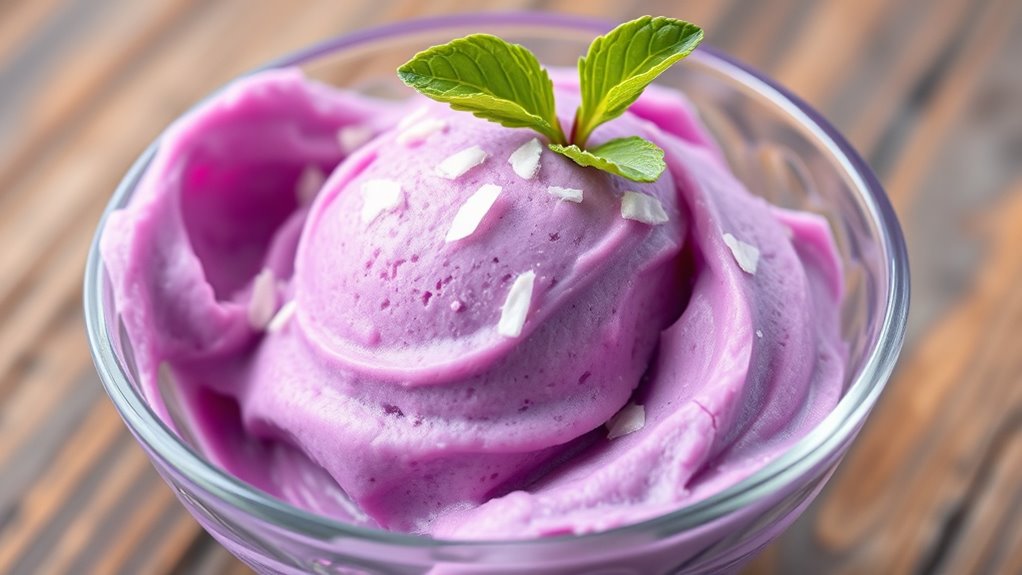Philippine ube gelato highlights the stunning purple yam’s earthy sweetness and vibrant color, turning it into a gorgeous, creamy dessert. You can enjoy its nutty flavor with hints of coconut, vanilla, or even cheese for a unique twist. The rich purple hue makes it a perfect conversation starter and a delightful treat for warm days or special occasions. Keep exploring to discover how to craft this visually striking dessert and elevate your culinary skills.
Key Takeaways
- Ube gelato showcases the vibrant purple hue and rich, nutty flavor of Filipino purple yam, making it visually stunning and culturally significant.
- It features a smooth, velvety texture with versatile flavor variations like coconut, pandan, or dulce de leche.
- The recipe blends cooked ube with cream, milk, and sugar, often incorporating tropical ingredients for added depth.
- Ube gelato is a nostalgic Filipino dessert, perfect for summer refreshment or special occasions, emphasizing its cultural heritage.
- Tips include maintaining color accuracy for authentic appearance and customizing flavors to enhance the unique yam flavor.

Have you ever tasted the vibrant, purple delight known as ube gelato? If not, you’re missing out on a treat that’s both visually stunning and irresistibly flavorful. Ube, or purple yam, offers a naturally sweet, nutty taste that’s enhanced when turned into creamy gelato. When you immerse yourself in this exotic dessert, you’re experiencing a flavor profile that combines earthiness with a subtle sweetness, making it uniquely satisfying. The rich purple hue alone makes it a conversation starter, but the real magic lies in its complex flavor and versatility.
If you’re eager to try making your own ube gelato, there are plenty of recipe ideas that can help you craft the perfect batch. A simple approach involves blending cooked ube with heavy cream, milk, sugar, and a touch of vanilla. You can also experiment by adding coconut milk to amplify the tropical vibe or mixing in bits of toasted coconut for added texture. For a more indulgent twist, swirl in dulce de leche or incorporate chunks of Filipino cheese for a salty contrast. The beauty of these recipe ideas is that they allow you to tailor the flavor profile to your liking, whether you prefer a purely sweet treat or something with a hint of saltiness or spice.
When you prepare ube gelato, you’re working with a flavor profile that’s both nostalgic and exotic. The earthy undertones of the yam are balanced by the sweetness, creating a rich, velvety experience on your palate. The natural purple color makes it visually appealing, but it’s the depth of flavor that truly captivates. As you explore different recipe ideas, you’ll discover how versatile ube can be. You might try adding a splash of coconut cream for a creamier texture or infusing your gelato base with pandan for a fragrant twist. Each variation highlights different facets of ube’s flavor profile, allowing you to customize your dessert while celebrating Filipino culinary heritage.
Ultimately, making ube gelato at home is about more than just taste; it’s about experiencing a cultural delight in your own kitchen. The process is straightforward, and the results are worth the effort. Whether you serve it as a refreshing summer treat or a rich dessert after dinner, ube gelato brings a touch of the Philippines to your table. Its vibrant color and complex flavor profile make it a standout choice for anyone looking to explore new dessert ideas. So, gather your ingredients, get creative with your recipe ideas, and enjoy the distinctive, delightful flavor profile of this purple yam-infused gelato—you’re about to indulge in something truly special. Additionally, understanding the color accuracy of the ingredients can help ensure your gelato turns out visually appealing and true to the authentic purple hue.
Frequently Asked Questions
What Are the Health Benefits of Eating Ube Gelato?
Eating ube gelato offers several health benefits. You’ll enjoy its antioxidant properties, which help combat free radicals and support your immune system. Ube also provides good nutritional value, including fiber, vitamins, and minerals that contribute to your overall well-being. Just remember to indulge in moderation, as it’s a sweet treat. Incorporating ube gelato into your diet can be a delicious way to boost your intake of beneficial nutrients.
How Is Ube Gelato Traditionally Prepared in the Philippines?
Imagine you’re crafting a treasured family recipe, blending tradition and local flavor. In the Philippines, ube gelato is made by boiling and mashing purple yams, then mixing with condensed milk, coconut milk, and sugar. Traditional recipes vary across regions, with some adding coconut flakes or cheese. You’d churn this mixture into a smooth, vibrant treat, capturing the essence of regional variations and cultural heritage.
Can Ube Gelato Be Made Vegan or Dairy-Free?
You can definitely make ube gelato vegan or dairy-free. By using vegan alternatives like coconut milk, almond milk, or cashew cream, you replace dairy ingredients effectively. Incorporate dairy-free ingredients such as agave syrup or coconut sugar for sweetness. This way, you preserve the rich, creamy texture and vibrant flavor of ube gelato while catering to vegan or lactose-intolerant diets. It’s a delicious, plant-based twist on a classic treat.
What Are the Best Accompaniments for Ube Gelato?
You’ll love pairing ube gelato with fresh fruit like sliced bananas or berries, which add a bright, invigorating contrast. For added texture, sprinkle crunchy toppings such as toasted nuts or cookie crumbles on top. These accompaniments enhance the creamy, sweet flavor of the ube, creating a delightful balance of textures and tastes. Keep it simple or get creative with your favorite fresh fruits and crunchy toppings for an irresistible treat.
How Does Ube Gelato Compare to Other Traditional Filipino Desserts?
You’ll find ube gelato stands out among traditional Filipino desserts because it combines vibrant color with rich, sweet flavor, making it a favorite. Did you know that Filipino desserts often carry deep cultural significance, reflecting history and identity? Compared to classics like halo-halo or bibingka, ube gelato offers a modern twist on colorful desserts, blending tradition with innovation, and allowing you to enjoy a creamy, flavorful experience rooted in Filipino heritage.
Conclusion
Now that you’ve discovered the vibrant allure of Philippine ube gelato, imagine the next scoop—what flavors will surprise you? Will that deep purple hue lead to a new favorite or an unexpected twist? With each spoonful, you’re not just tasting a treat; you’re savoring a piece of history and culture. So, are you ready to explore more flavors that could change your dessert game forever? The adventure is just beginning—are you in?









